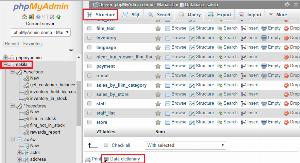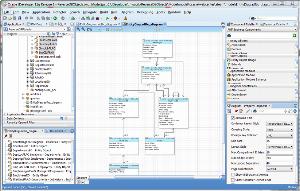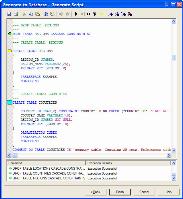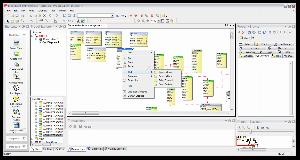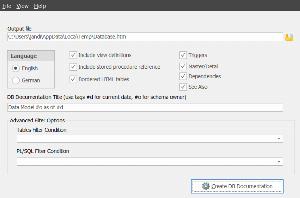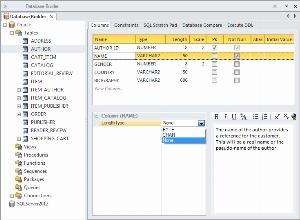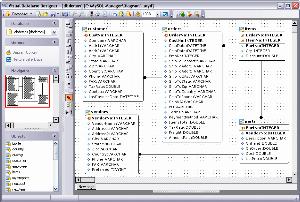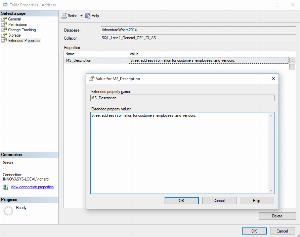Data dictionary tools
List of tools that enable design and building of data dictionaries .
Data Dictionary is a set of important information about data used within an organization (metadata). This information includes names, definitions, and attributes about data, owners, and creators of assets. Data Dictionary tools provide insights into meaning and purposes of data elements. They add useful aliases about the scope and characteristics of data elements, as well as the rules for their usage and application.
ERBuilder Data Modeler
ERBuilder Data Modeler allows developers to graphically design databases by using entity relationship diagrams, and automatically generates the most popular SQL databases.
| Desktop/Cloud: | Desktop |
|---|---|
| ER Diagram: |
|
| Export: | HTML |
| Metadata stored in: | Database metadata |
| Commercial: | Commercial |
| Free edition: |
|
| Notable features: | Entity relation diagram, Reverse engineering database, Data Definition Language (DDL) script |
| Runs on: (for desktop): | Windows |
phpMyAdmin
PhpMyAdmin is a popular web-based MySQL and MariaDB administration tool. Frequently used operations in PhpMyAdmin are managing databases, tables, columns, relations, indexes, users and permissions, and can be performed via the user interface, while you still have the ability to directly execute any SQL statement. PhpMyAdmin allows you to export data dictionary to HTML.
| Desktop/Cloud: | Desktop |
|---|---|
| ER Diagram: |
|
| Export: | HTML |
| Metadata stored in: | Database metadata |
| Commercial: | Free |
| Free edition: |
|
| Notable features: | Free database designing and managing tool |
| Runs on: (for desktop): | Linux,Mac OS,Windows |
ER/Studio
ER/Studio Data Architect helps to easily reverse- and forward-engineer, compare and merge, and visually document data assets across multiple platforms and data sources. The Data Dictionary is a feature of ER/Studio that allows the sharing of many objects including domains, defaults, rules, and attachments. Using the Data Dictionary you can enforce standards, promote reuse, and build a common framework across all models.
| Desktop/Cloud: | Desktop |
|---|---|
| ER Diagram: |
|
| Export: | HTML |
| Metadata stored in: | Documentation repository/file |
| Commercial: | Commercial |
| Free edition: |
|
| Notable features: | Data modeler, Entity relation diagram, Model sharing |
| Runs on: (for desktop): | Windows |
Xcase
Xcase is a complete database design tool engineered to help you accomplish all your database-related tasks – from database design to modeling to daily modifications – with greater speed and higher quality. It provides access and edit feature for all meta-data attributes (including your own) using customizable browsers and attribute inspectors and provides a fully customizable data dictionary which allows you to include user-defined attributes.
| Desktop/Cloud: | Desktop |
|---|---|
| ER Diagram: |
|
| Export: | CSV |
| Metadata stored in: | Program metadata |
| Commercial: | Commercial |
| Free edition: |
|
| Notable features: | Fast and accurate database modeling tool |
| Runs on: (for desktop): | Windows |
Oracle JDeveloper
Oracle JDeveloper is a free integrated development environment that simplifies the development of Java-based applications addressing every step of the application lifecycle. Through this tool you can perform offline database development, model existing database tables to create a new view offline, generate changes back to the database, and document your database.
| Desktop/Cloud: | Desktop |
|---|---|
| ER Diagram: |
|
| Export: | HTML,PDF |
| Metadata stored in: | Documentation repository/file |
| Commercial: | Free |
| Free edition: |
|
| Notable features: | Free data modeling tool, Entity relation diagram, Reverse engineering |
| Runs on: (for desktop): | Linux,Mac OS,Windows |
ModelRight
ModelRight is a database design and data modeling tool. It provides the documentation of your database with richly formatted notes, definitions, comments, and revision notes.
| Desktop/Cloud: | Desktop |
|---|---|
| ER Diagram: |
|
| Export: | HTML |
| Metadata stored in: | Database metadata |
| Commercial: | Commercial |
| Free edition: |
|
| Notable features: | Entity relation diagram, reverse engineering, compare models, innovative user-interface |
| Runs on: (for desktop): | Windows |
KeepTool
KeepTool contains tools designed to streamline design, administration and program development. With the KeepTool DB Doc tool, you can generate appealing documentation of your database in HTML format for entire schema.
| Desktop/Cloud: | Desktop |
|---|---|
| ER Diagram: |
|
| Export: | HTML |
| Metadata stored in: | Database metadata |
| Commercial: | Commercial |
| Free edition: |
|
| Notable features: | SQL editor, Reverse engineering database, Entity relationship diagram, Compare database |
| Runs on: (for desktop): | Windows |
MagicDraw
MagicDraw is the award-winning business process, architecture, software and system modeling tool with teamwork support. It includes the entity-relationship diagram, SQL database modeling/diagramming and DDL script generation/reverse features. Its automatic report generation engine rapidly-produce comprehensive, professional requirements, software design documentation, elements of MagicDraw data dictionary, and other types of reports.
| Desktop/Cloud: | Desktop |
|---|---|
| ER Diagram: |
|
| Export: | HTML,PDF,RTF |
| Metadata stored in: | Program metadata |
| Commercial: | Commercial |
| Free edition: |
|
| Notable features: | User-friendly visual interface, fast database modeling, Work collaboratively on the same model, Automatic report generation |
| Runs on: (for desktop): | Linux,Mac OS,Windows |
WinA&D
WinA&D is a comprehensive tool for system analysis, requirements management, structured analysis and design, object-oriented modeling with UML and data modeling of information systems. It supports code generation, integrated code browsing, linked text specifications or foreign documents and data dictionary.
| Desktop/Cloud: | Desktop |
|---|---|
| ER Diagram: |
|
| Export: | HTML,PDF |
| Metadata stored in: | Program metadata |
| Commercial: | Commercial |
| Free edition: |
|
| Notable features: | System models & simulation, code generation from models, models from code, custom project reports |
| Runs on: (for desktop): | Mac OS,Windows |
SQL Power Architect
SQL Power Architect data modeling tool has many unique features geared specifically for the data warehouse architect. It is a powerful database utility that not only builds diagrams of databases, but also provides data dictionary language output, which can be used to build database solutions.
| Desktop/Cloud: | Desktop |
|---|---|
| ER Diagram: |
|
| Export: | HTML |
| Metadata stored in: | Program metadata |
| Commercial: | Commercial |
| Free edition: |
|
| Notable features: | Connects to multiple source databases concurrently, Compares data models & database structures and identifies discrepancies, Generates source-to-target visual Mapping Reports, Forward/reverse engineers PostgreSQL, Oracle, MS SQL Server & more |
| Runs on: (for desktop): | Mac OS,Windows |
Enterprise Architect
Enterprise Architect is a fully featured database modeling platform that enables the user to work with their Physical Data models at all stages, from design right through to the implementation of the live database. With Enterprise Architect, a data dictionary can be created that defines data elements, including details such as names, aliases descriptions and allowable values.
| Desktop/Cloud: | Desktop |
|---|---|
| ER Diagram: |
|
| Export: | HTML |
| Metadata stored in: | Program metadata |
| Commercial: | Commercial |
| Free edition: |
|
| Notable features: | Entity relationship diagram, Integrated modeling platform, visual execution analysis, code generation, reverse engineering and scripting |
| Runs on: (for desktop): | Linux,Mac OS,Windows |
SQL Manager
SQL Manager simplifies and automates your database development process and design, explore and maintain existing databases, build compound SQL query statements, manage database user rights, and manipulate data in different ways. The functionality of Create Report Wizard allows you to create simple database objects reports in a few clicks.
| Desktop/Cloud: | Desktop |
|---|---|
| ER Diagram: |
|
| Export: | HTML,PDF |
| Metadata stored in: | Database metadata |
| Commercial: | Commercial |
| Free edition: |
|
| Notable features: | Simple management of all MySQL objects, Advanced data manipulation tools, Report designer with clear in use report construction wizard |
| Runs on: (for desktop): | Windows |
Hackolade
Hackolade is a tool for Agile visual data modeling for JSON and NoSQL databases. It provides graphic visualization of complex data structures using Entity-Relationship diagrams to represent denormalized data in a user-friendly way. Besides that, it provides the functionality of designing one data dictionary of objects and using it in different models.
| Desktop/Cloud: | Desktop |
|---|---|
| ER Diagram: |
|
| Export: | HTML,PDF |
| Metadata stored in: | Program metadata |
| Commercial: | Commercial |
| Free edition: |
|
| Notable features: | Graphical visualization, forward and reverse engineering, data governance, data model documentation |
| Runs on: (for desktop): | Linux,Mac OS,Windows |
PLDoc
PLDoc is an open-source utility for generating HTML documentation of code written in Oracle PL/SQL. Working similarly to JavaDoc, it parses PL/SQL packages, object types, functions, procedures, and triggers, finding and editing comments of definitions and building HTML format technical documentation for your project.
| Desktop/Cloud: | Desktop |
|---|---|
| ER Diagram: |
|
| Export: | HTML |
| Metadata stored in: | Program metadata |
| Commercial: | Free |
| Free edition: |
|
| Notable features: | Open-source documentation tool, Analogous to javadoc for Java |
| Runs on: (for desktop): | Windows |
Document! X
Document! X provides automatic documentation of SQL Server, Access, Oracle and other OLE DB databases. The generated database documentation is an accurate and comprehensive documentation set covering Schemas, Tables, Columns, Indexes, Relationships, Views, Stored Procedures, Triggers, etc. Besides that, you can extend the source descriptions using the rich authoring environment provided by the Document! X Content File Editor.
| Desktop/Cloud: | Desktop |
|---|---|
| ER Diagram: |
|
| Export: | XML |
| Metadata stored in: | Database metadata |
| Commercial: | Commercial |
| Free edition: |
|
| Notable features: | Automated accurate and comprehensive documentation |
| Runs on: (for desktop): | Windows |
Key functionality of Data Dictionary tools is to give users the ability to document data. Moreover, very important is the possibility to create a collection of multiple repositories, based on different system engines. For a better understanding of the data, some tools allow visualization of the data structure using ERD (Entity-Relationship Diagrams).
From the organization's point of view, a community module within a data dictionary tool proves to be useful. It facilitates the proper information flow, as well as provides sharing opinions on specific objects among the members of an organization.
Nowadays, data discovery and understanding becomes crucial for proper organization performance. There are many benefits to using Data Dictionaries, such as:
• helps avoid data inconsistencies problems,
• it allows introducing unified nomenclature used in the project,
• Make data searchable, and understandable,
• Create a single source of truth about the data from different repositories,
The prepared list includes simple, open-source data dictionaries as well as more advanced software.
 SQL Server
SQL Server
 Oracle
Oracle
 MySQL
MySQL
 PostgreSQL
PostgreSQL
 Amazon Redshift
Amazon Redshift
 Azure SQL Database
Azure SQL Database
 DBT
DBT
 Google Big Query
Google Big Query
 IBM DB2
IBM DB2
 MariaDB
MariaDB
 SAP HANA
SAP HANA
 Snowflake
Snowflake
 SQLite
SQLite
 Teradata
Teradata
 Vertica
Vertica


